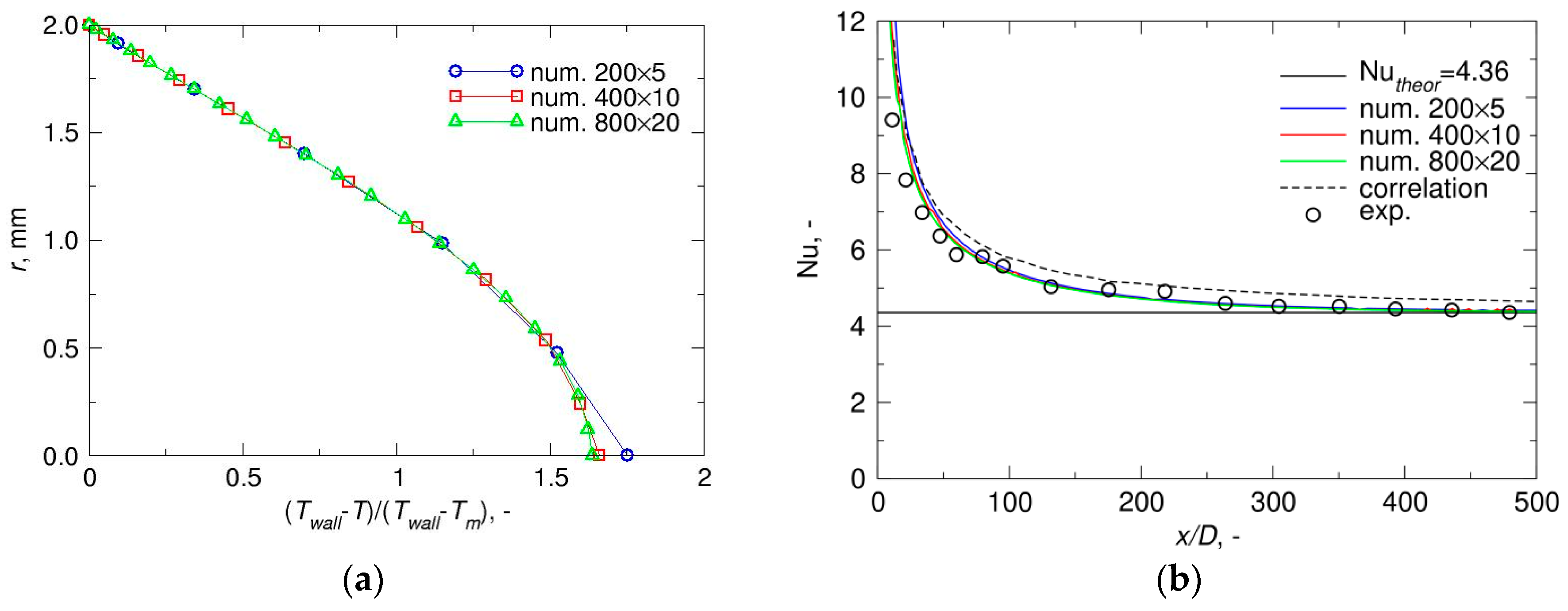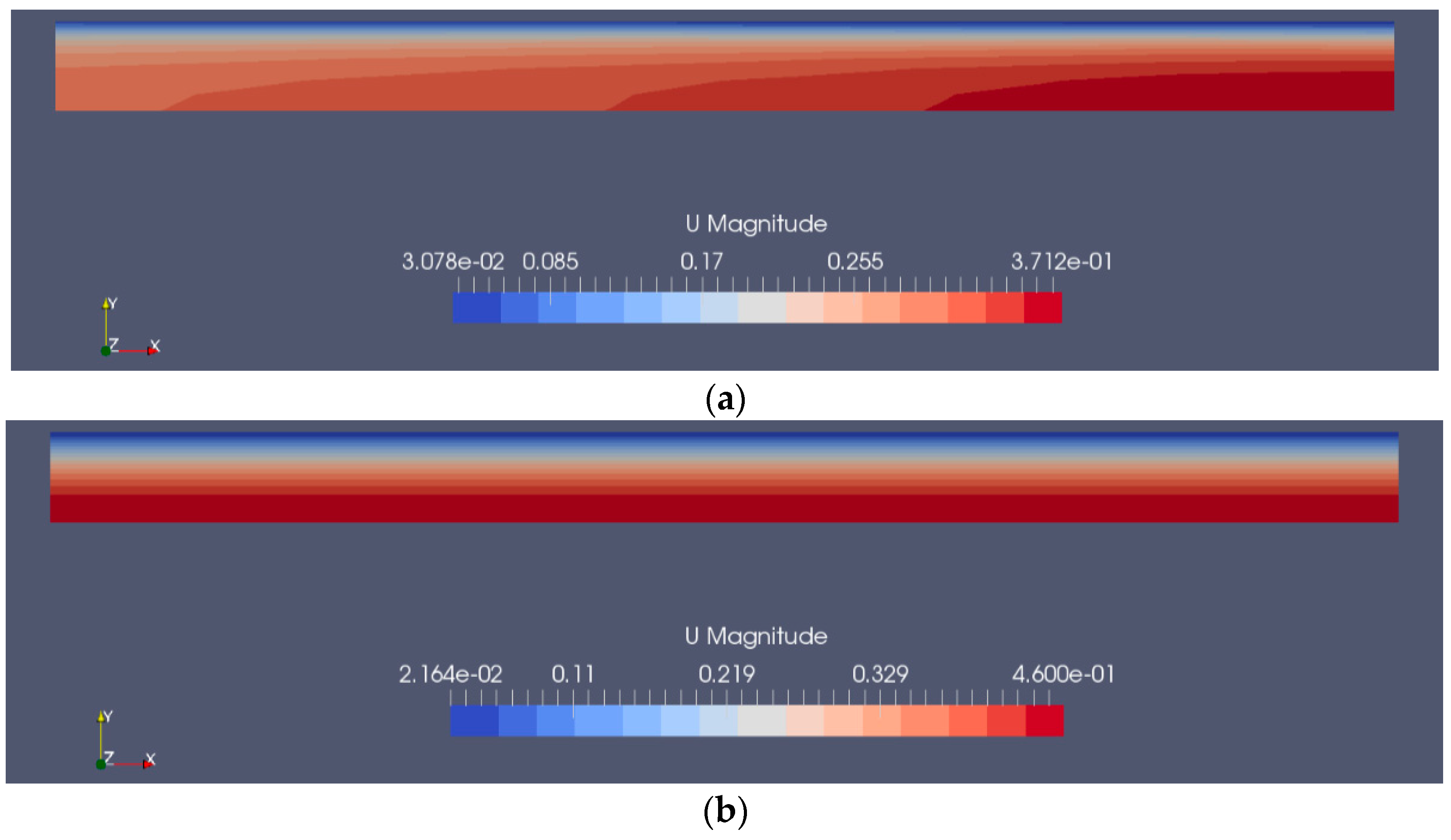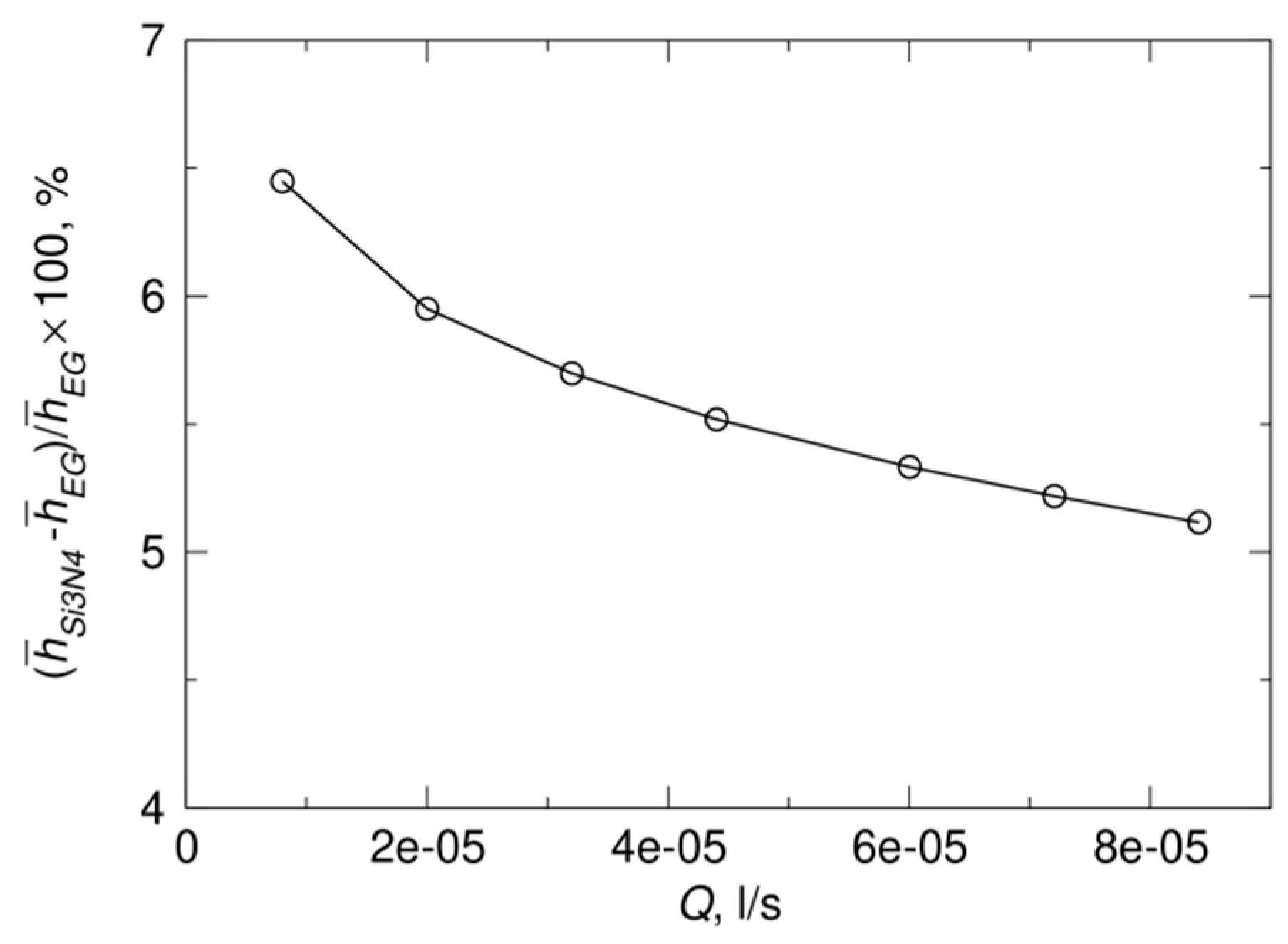Computational Study of Flow and Heat Transfer Characteristics of EG-Si3N4 Nanofluid in Laminar Flow in a Pipe in Forced Convection Regime †
Abstract
:1. Introduction
2. Computational Model
2.1. Governing Transport Equations and Constitutive Relations
2.2. Geomery Modeling and Numerical Mesh
2.3. Discretization of Transport Equations and Boundary Conditions
- inlet: U = (Uin, 0, 0), ∇p = 0,
- pipe wall: U = (0, 0, 0), ∇p = 0,
- outlet: ∇U = 0, p = pout.
- inlet: T = Tin,
- pipe wall: ∇T = q/k, where q is the applied wall heat flux,
- outlet: ,
- Set all fields to initial values.
- Assemble and solve the under-relaxed momentum equation (momentum predictor).
- Assemble and solve the pressure equation and calculate the conservative volume fluxes, then update the pressure field with under-relaxation and correct the velocity explicitly.
- Solve the temperature equation using the available volume fluxes, pressure and velocity fields; under-relax the equation implicitly in order to improve convergence.
- Check convergence for all equations; if the system is not converged, start a new iteration from the step 2.
3. Results
3.1. Verification of the Computational Model
3.2. Results for the EG-Si3N4 Nanofluid
3.3. Discussion on the Performance Evaluation
4. Conclusions
Author Contributions
Acknowledgments
Conflicts of Interest
References
- Choi, S.U.; Eastman, J.A. Enhancing Thermal Conductivity of Fluids with Nanoparticles; Technical report, TRN: 96:001707; Argonne National Laboratory: Argonne, IL, USA, 1995.
- Bianco, V.; Manca, O.; Nardini, S.; Vafai, K. Heat Transfer Enhancement with Nanofluids, 1st ed.; CRC Press: Boca Raton, FL, USA, 2017; pp. 207–287. [Google Scholar]
- Huminic, G.; Huminic, A. Application of nanofluids in heat exchangers: A review. Renew Sustain. Energy Rev. 2012, 16, 5625–5638. [Google Scholar] [CrossRef]
- Boukerma, K.; Kadja, M. Convective Heat Transfer of Al2O3 and CuO Nanofluids Using Various Mixtures of Water-Ethylene Glycol as Base Fluids. Eng. Technol. Appl. Sci. Res. 2017, 7, 1496–1503. [Google Scholar]
- Madhesh, D.; Kalaiselvam, S. Experimental study on the heat transfer and flow properties of Ag–ethylene glycol nanofluid as a coolant. Heat Mass Transf. 2014, 50, 1597–1607. [Google Scholar] [CrossRef]
- Wong, K.V.; De Leon, O. Applications of Nanofluids: Current and Future. Adv. Mech. Eng. 2010, 2, 1–11. [Google Scholar] [CrossRef] [Green Version]
- Bhanvase, B.A.; Sarode, M.R.; Putterwar, L.A.; Abdullah, K.A.; Deosarkar, M.P.; Sonawane, S.H. Intensification of convective heat transfer in water/ethylene glycol based nanofluids containing TiO2 nanoparticles. Chem. Eng. Process. 2014, 82, 123–131. [Google Scholar] [CrossRef]
- Sundar, L.S.; Singh, M.K.; Sousa, A.C.M. Enhanced heat transfer and friction factor of MWCNT–Fe3O4/water hybrid nanofluids. Int. Commun. Heat Mass Transf. 2014, 52, 73–83. [Google Scholar] [CrossRef]
- Li, Y.; Zhou, J.; Luo, Z.; Tung, S.; Schneider, E.; Wu, J.; Li, X. Investigation on two abnormal phenomena about thermal conductivity enhancement of BN/EG nanofluids. Nanoscale Res. Lett. 2011, 6, 1–7. [Google Scholar] [CrossRef] [Green Version]
- Ilhan, B.; Kurt, M.; Ertürk, H. Experimental investigation of heat transfer enhancement and viscosity change of hBN nanofluids. Exp. Therm. Fluid Sci. 2016, 77, 272–283. [Google Scholar] [CrossRef]
- Zyła, G.; Fal, J.; Traciak, J.; Gizowska, M.; Perkowski, K. Huge thermal conductivity enhancement in boron nitride–ethylene glycol nanofluids. Mater. Chem. Phys. 2016, 180, 250–255. [Google Scholar] [CrossRef]
- Zyła, G.; Fal, J. Experimental studies on viscosity, thermal and electrical conductivity of aluminum nitride–ethylene glycol (AlN–EG) nanofluids. Thermochim. Acta 2016, 637, 11–16. [Google Scholar] [CrossRef]
- Zyła, G.; Fal, J.; Estellé, P. Thermophysical and dielectric profiles of ethylene glycol based titanium nitride (TiN–EG) nanofluids with various size of particles. Int. J. Heat Mass Transf. 2017, 113, 1189–1199. [Google Scholar] [CrossRef]
- Sarafraz, M.M.; Safaei, M.R.; Tian, Z.; Goodarzi, M.; Filho, E.P.B.; Arjomandi, M. Thermal Assessment of Nano-Particulate Graphene-Water/Ethylene Glycol (WEG 60:40) Nano-Suspension in a Compact Heat Exchanger. Energies 2019, 12, 1929. [Google Scholar] [CrossRef] [Green Version]
- Akbari, M.; Galanis, N.; Behzadmehr, A. Comparative analysis of single and two-phase models for CFD studies of nanofluid heat transfer. Int. J. Therm. Sci. 2011, 50, 1343–1354. [Google Scholar] [CrossRef]
- Ravnik, J.; Škerget, L.; Yeigh, B.W. Nanofluid natural convection around a cylinder by BEM. WIT Trans. Model. Sim. 2015, 61, 261–271. [Google Scholar]
- Ravnik, J.; Škerget, L. Simulation of flow of nanofluids by BEM. WIT Trans. Model. Sim. 2010, 50, 3–14. [Google Scholar]
- Minea, A.A.; Buonomo, B.; Burggraf, J.; Ercole, D.; Karpaiya, K.R.; Di Pasqua, A.; Sekrani, G.; Steffens, J.; Tibaut, J.; Wichmann, N.; et al. NanoRound: A benchmark study on the numerical approach in nanofluids’ simulation. Int. Commun. Heat Mass Transf. 2019, 108, 104292. [Google Scholar] [CrossRef]
- Titan, C.P.; Morshed, A.K.M.M.; Khan, J.A. Nanoparticle enhanced ionic liquids (NEILS) as working fluid for the next generation solar collector. Procedia Eng. 2013, 56, 631–636. [Google Scholar]
- Bhattacharjee, A.; Luís, A.; Santos, J.H.; Lopes-da-Silva, J.A.; Freire, M.G.; Carvalhoa, P.J.; Coutinho, J.A.P. Thermophysical properties of sulfonium- and ammonium-based ionic liquids. Fluid Phase Equilib 2014, 381, 36–45. [Google Scholar] [CrossRef] [Green Version]
- Titan, P.C.; Morshed, A.K.M.M.; Fox, E.B.; Visser, A.N.; Bridges, N.J.; Khan, J.A. Thermal performance of ionic liquids for solar thermal applications. Exp. Therm. Fluid Sci. 2014, 59, 88–95. [Google Scholar]
- Titan, P.C.; Morshed, A.K.M.M.; Fox, E.B.; Khan, J.A. Effect of nanoparticle dispersion on thermophysical properties of ionic liquids for its potential application in solar collector. Procedia Eng. 2014, 90, 643–648. [Google Scholar]
- Titan, P.C.; Morshed, A.K.M.M.; Fox, E.B.; Khan, J.A. Thermal performance of Al2O3 Nanoparticle Enhanced Ionic Liquids (NEILs) for Concentrated Solar Power (CSP) applications. Int. J. Heat Mass Transf. 2015, 85, 585–594. [Google Scholar]
- Titan, P.C.; Morshed, A.K.M.M.; Fox, E.B.; Khan, J.A. Enhanced thermophysical properties of NEILs as heat transfer fluids for solar thermal applications. Appl. Therm. Eng. 2017, 110, 1–9. [Google Scholar]
- Chereches, E.I.; Sharma, K.V.; Minea, A.A. A numerical approach in describing ionanofluids behavior in laminar and turbulent flow. Contin. Mech. Thermodyn. 2018, 30, 657–666. [Google Scholar] [CrossRef]
- Minea, A.A.; Sohel Murshed, S.M. A review on development of ionic liquid based nanofluids and their heat transfer behavior. Renew Sustain Energy Rev. 2018, 91, 584–599. [Google Scholar] [CrossRef]
- Mukherjee, S.; Paria, S. Preparation and Stability of Nanofluids-A Review. IOSR-JMCE 2013, 9, 63–69. [Google Scholar] [CrossRef]
- Sharma, B.S.K.; Gupta, S.M. Preparation and evaluation of stable nanofluids for heat transfer application: A review. Exp. Therm. Fluid Sci 2016, 79, 202–212. [Google Scholar]
- Zhao, M.; Lv, W.; Li, Y.; Dai, C.; Zhou, H.; Song, X.; Wu, Y. A Study on Preparation and Stabilizing Mechanism of Hydrophobic Silica Nanofluids. Materials 2018, 11, 1385. [Google Scholar] [CrossRef] [Green Version]
- Alirezaie, A.; Hajmohammad, M.H.; Alipour, A.; Salari, M. Do nanofluids affect the future of heat transfer? A benchmark study on the efficiency of nanofluids. Energy 2018, 157, 979–989. [Google Scholar] [CrossRef]
- Yu, W.; Xie, H.; Li, Y.; Chen, L. Experimental investigation on thermal conductivity and viscosity of aluminum nitride nanofluid. Particuology 2011, 9, 187–191. [Google Scholar] [CrossRef]
- Hussein, A.M.; Noor, M.M.; Kadirgama, K.; Ramasamy, D. Heat transfer enhancement using hybrid nanoparticles in ethylene glycol through a horizontal heated tube. Int. J. Automot. Mech. Eng. 2017, 14, 4183–4419. [Google Scholar] [CrossRef]
- Zyła, G.; Vallejo, J.P.; Lugo, L. Isobaric heat capacity and density of ethylene glycol based nanofluids containing various nitride nanoparticle types: An experimental study. J. Mol. Liq. 2018, 261, 530–539. [Google Scholar] [CrossRef]
- Abbasi, F.M.; Gul, M.; Shehzad, S.A. Hall effects on peristalsis of boron nitride-ethylene glycol nanofluid with temperature dependent thermal conductivity. Physica E 2018, 99, 275–284. [Google Scholar] [CrossRef]
- Zyla, G.; Fal, J.; Bikić, S.; Wanic, M. Ethylene glycol-based silicon nitride nanofluids: An experimental study on their thermophysical, electrical and optical properties. Physica E 2018, 104, 82–90. [Google Scholar] [CrossRef]
- Wikki Consultancy and Software Developement Using Foam-Extend and OpenFOAM®. Available online: http://wikki.gridcore.se/foam-extend (accessed on 24 September 2019).
- OpenFOAM The Open-Source CFD Toolbox. Available online: https://www.openfoam.com/ (accessed on 24 September 2019).
- Meyer, J.P.; Everts, M. Single-phase mixed convection of developing and fully developed flow in smooth horizontal circular tubes in the laminar and transitional flow regimes. Int. J. Heat Mass Transf. 2018, 117, 1251–1273. [Google Scholar] [CrossRef] [Green Version]
- Bergman, T.L.; Lavine, A.S.; Incropera, F.P.; Dewitt, D.P. Fundamentals of Heat and Mass Transf., 7th ed.; John Wiley & Sons Inc.: Hoboken, NJ, USA, 2011; pp. 518–558. [Google Scholar]
- Jasak, H. Error Analysis and Estimation for the Finite Volume Method with Applications to Fluid Flows. Ph.D. Thesis, Imperial College of Science, Technology and Medicine, London, UK, June 1996. [Google Scholar]
- Shah, R.K.; London, A.L. Laminar Flow Forced Convection in Ducts, 1st ed.; Academic Press: New York, NY, USA, 1978; pp. 78–138. [Google Scholar]
- Prasher, R.; Song, D.; Wang, J.; Phelan, P. Measurements of nanofluid viscosity and its implications for thermal applications. Appl. Phys. Lett. 2006, 89, 133108. [Google Scholar] [CrossRef]
- Wu, Z.; Feng, Z.; Sundén, B.; Wadsö, L. A comparative study on thermal conductivity and rheology properties of alumina and multi-walled carbon nanotube nanofluids. Front. Heat Mass Transf. 2014, 5, 1–10. [Google Scholar]
- Sekrani, G.; Poncet, S.; Proulx, P. Modelling of convective turbulent heat transfer of water-based Al2O3 nanofluids in a uniformly heated pipe. Chem. Eng. Sci. 2018, 176, 205–219. [Google Scholar] [CrossRef]










| Pipe Diameter D | Pipe Length L | Inlet Temperature Tin | Wall Heat Flux q | Reynolds Number Re |
|---|---|---|---|---|
| 4 mm | 5 m | 293 K | 1000 W/m2 | 965 |
| Pipe Diameter D | Pipe Length L | Inlet Temperature Tin | Wall Heat Flux q | Volume Flow Rate Q | Nanoparticle Volume Fraction φv |
|---|---|---|---|---|---|
| 4 mm | 2 m | 293 K | 10 kW/m2 | 8 × 10−6–8.4 × 10−5 m3/s | 0–0.035 |
| Density ρ | Specific Heat cp | Heat Conductivity k |
|---|---|---|
| 1109.67 kg/m3 | 2458.3 J/(kg K) | 0.2429 W/(m K) |
| Density ρ | Specific Heat cp | Heat Conductivity k |
|---|---|---|
| 3400 kg/m3 | 540 J/(kg K) | 16.7 W/(m K) |
| Nanoparticle Volume Fraction φv | Thermal Conductivity Ratio knf/kbf | Viscosity Ratio (μnf/μbf)1/3 |
|---|---|---|
| 0.0 | 1 | 1 |
| 0.0033 | 1.00947 | 1.04483 |
| 0.0066 | 1.01894 | 1.05741 |
| 0.01 | 1.02870 | 1.07655 |
| 0.0134 | 1.03846 | 1.11588 |
| 0.0169 | 1.04850 | 1.13608 |
| 0.0258 | 1.07404 | 1.24519 |
| 0.035 | 1.100450 | 1.44602 |
© 2019 by the authors. Licensee MDPI, Basel, Switzerland. This article is an open access article distributed under the terms and conditions of the Creative Commons Attribution (CC BY) license (http://creativecommons.org/licenses/by/4.0/).
Share and Cite
Berberović, E.; Bikić, S. Computational Study of Flow and Heat Transfer Characteristics of EG-Si3N4 Nanofluid in Laminar Flow in a Pipe in Forced Convection Regime. Energies 2020, 13, 74. https://doi.org/10.3390/en13010074
Berberović E, Bikić S. Computational Study of Flow and Heat Transfer Characteristics of EG-Si3N4 Nanofluid in Laminar Flow in a Pipe in Forced Convection Regime. Energies. 2020; 13(1):74. https://doi.org/10.3390/en13010074
Chicago/Turabian StyleBerberović, Edin, and Siniša Bikić. 2020. "Computational Study of Flow and Heat Transfer Characteristics of EG-Si3N4 Nanofluid in Laminar Flow in a Pipe in Forced Convection Regime" Energies 13, no. 1: 74. https://doi.org/10.3390/en13010074




